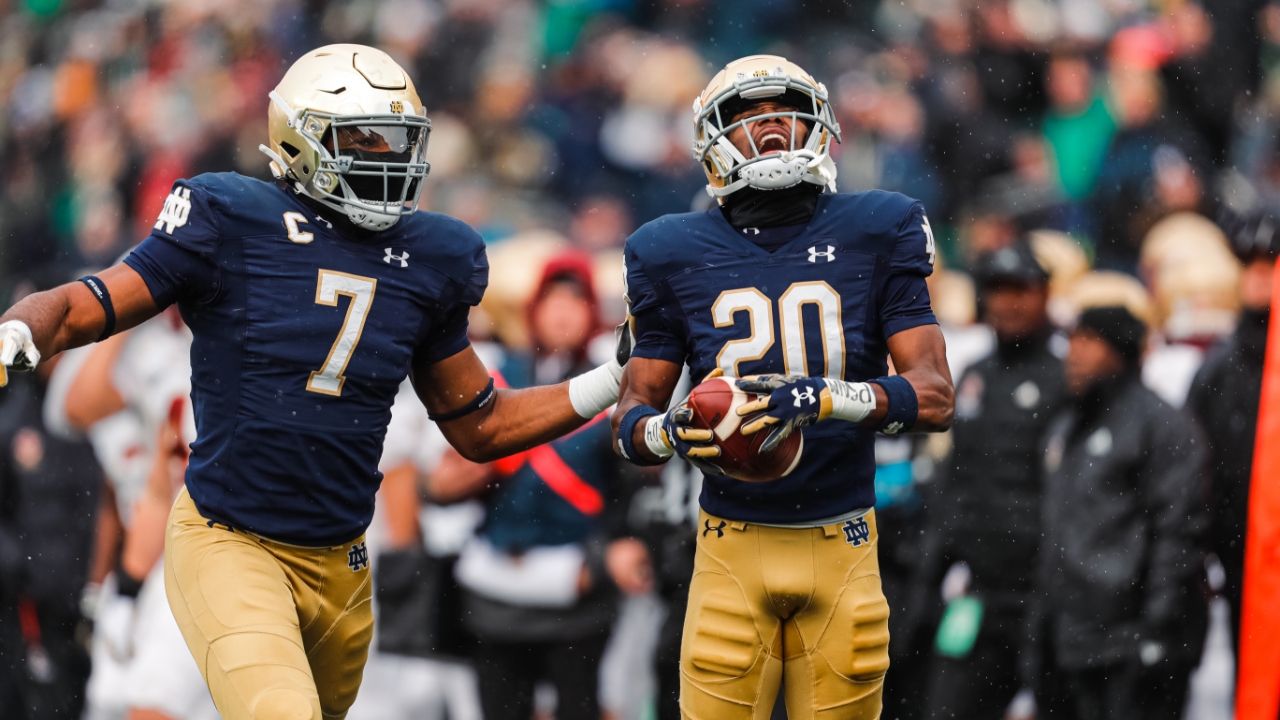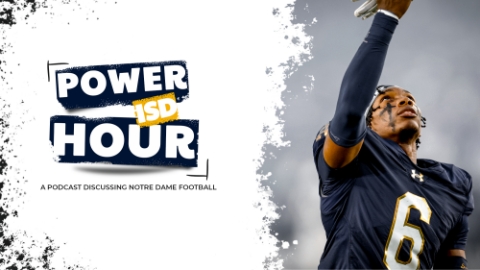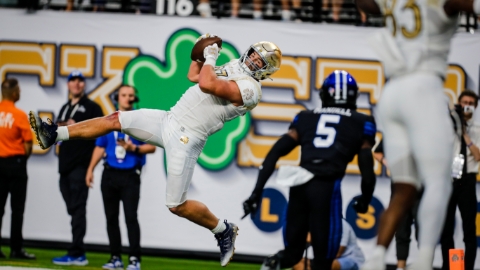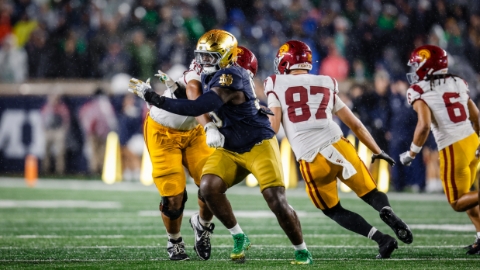
There was something interesting about the NFL’s most recent All-Pro team and it wasn’t Zack Martin making it for the 145th consecutive time. (Although, that’s pretty cool. They can start working on his bust for Canton now)
No, the most interesting thing was the difference in recruiting rankings for the offensive and defensive players.
The offense had several under the radar recruits who developed into the best players at their position in the NFL. In fact, Martin was the only 4-star recruit out of the 11 first team players. The defense was the exact opposite. The average star ranking was 4.5 for the 11 players, including seven former 5-stars.
There’s some good insight in the article as to why that may be the case. The consensus amongst the people Feldman talked to in the pro and college game was that scheme fit seemed to matter a lot more on offense than defense. With defenders, the players with the freakiest athletic and physical traits are easier to evaluate and can stand out regardless of scheme.
It’s one reason why a former 5-star like Jaylen Sneed could be a critically important player for the Irish in the next few years and why they need more like him. It’s also something to think about when looking at Notre Dame targets on the defensive side of the ball.
Sure, you can’t measure grit or heart and how a player might handle adversity at the college level. All of that doesn’t matter that much if a defender doesn’t have the necessary physical traits to excel.
It would be naive to act like coaching does not matter on defense compared to offense. I’ve seen teams who are seemingly loaded with highly ranked recruits play average defense because of the wrong coordinator. With that being said, I don’t think it’s a coincidence that four of the top-seven defenses is DF+ (combined SP+ and FEI defensive ratings) are Georgia, Alabama, Michigan, and Penn State. (It’s also not a coincidence that two of the other seven play in the Big Ten West. Zing!)
Notre Dame’s roster at the moment has 26 of 43 defenders who were former blue-chip recruits (4 or 5-stars). A 60.4% blue-chip ratio is not bad at all, but there are a couple of things that the total number doesn’t articulate. The first is that the ratio in the most recent classes that Marcus Freeman signed is 80% (16 of 20). That means that the ratio for the upperclassmen on defense is 43.5 % (10 of 23). Most of the top raw talent is young.
The second is that there is a big difference between the defensive line and linebackers and the secondary. The defensive line ratio is 68.8%. The linebacker ratio is 63.6%. The defensive back ratio is 50%. Take away the five freshmen blue-chips they just signed and it’s 27.3%.
They clearly needed a talent upgrade on the back end of the defense and they accomplished it in the last two classes. It’s already paid off with Benjamin Morrison and I think we’re going to see it with Jaden Mickey this season as well.
And because raw talent matters more, I wouldn’t be surprised if we see it with two or three freshmen who end up being contributors this season. We may get a glimpse of it this spring with Christian Gray, Adon Shuler, and Ben Minich on campus as early enrollees.
I can only imagine where the defense would have been if Morrison hadn’t been as good as he was last season. I think the defense will probably need at least a couple of these freshmen defensive backs to step up for the Irish this season in order for the defense to be significantly better.
They probably don’t need to be as good as Morrison was, but they’ll need them to be factors to upgrade the unit as a whole.
2. I was thinking of the first impression I had of Morrison in fall camp last year and it was obviously a positive one. It was one of those instances where I didn’t need to watch him for too long to know he was going to play at Notre Dame.
I didn’t know he was going to make the immediate impact he did, but was confident he would make play in year one and make an impact at some point. It made me think of the first impressions I have had from freshmen over the years I’ve worked for ISD.
Players like Josh Adams, KJ Stepherson, Cole Kmet, and Jeremiah Owusu-Koramoah are some players I vividly remember seeing and being sold on immediately in August of their freshman seasons.
There are a couple who I was impressed with as early enrollees that ended up not doing much at Notre Dame. I thought Isaiah Robertson looked like a player in his first spring and Houston Griffith had me convinced he was going to be someone who eventually developed into an impact defender. For the most part, though, the ones who had a strong first impression ended up being really good at Notre Dame.
Which one of the young defensive backs can make a strong first impression in practice this spring or summer? That’s something I’ll be anxious to see this year.
3. 1990 was 33 years ago. The best way to remind a college football fan of that is that Colorado and Georgia Tech split the national championship that season.
Even with Coach Prime in Boulder, those two programs aren’t going to split anything other than the check at an Cheez-It Bowl pre-game dinner.
The days of the middle tier rising to the top in college football are done and have been ever since then. All anyone needs as evidence is to look at the list of national champions. It’s blue-blood on top of blue-blood. There isn’t a TCU or a Utah mixed in. There have been ups and downs for certain top tier programs over that time, but we’re now in an era where the rich get richer and other than Oregon trying to buy their way to elite status, no one is really close to joining the programs who are a notch above in most aspects.
In recruiting, it looks like the gap between the top programs and everyone else is widening too. The best programs, Notre Dame included, are now recruiting at another level compared to even five years ago.
From 2014-2018, the average number of programs who signed 16 blue-chips (4 or 5-star recruits) or more in a class was 4.8. In the five recruiting cycles since then, the number has gone up to 8.8. There were 12 programs this year who signed at least 16 blue-chips in the composite rankings (Notre Dame signed 20).
I was thinking this was all about the rich getting richer and that is true to a certain extent. One look at the recruiting rankings would back that up. Check out the top-15 teams and it’s just about all of the usual suspects.
But I also looked at the number of composite blue-chips there are now compared to five years ago and there are 70 more in this past cycle than there was in 2018. There’s 20 more this year than the previous cycle. There are 46 more than there were two years ago.
I don’t know if the number will keep going up and I’m not even saying that 446 players aren’t worthy of being ranked as 4-stars, I’m just saying that there are more than there used to be. That also makes it seem like the industry could use a refresh when it comes to separating prospects because the 38th ranked player and the 446th ranked player are both 4-stars and there is a big difference in the projection for those two players. The same goes for 3-stars and hundreds of them who are lumped together.
No one is going to switch the star system any time soon because people are used to it, but keeping something because people are used to it is a dumb reason to not change it. I do think there is an easy solution to it by being separating prospects into tiers by grade, but then people wouldn’t be able to take as much credit for ranking someone a 4-star who ends up being a first round pick rather than putting them in a tier that projected them to be a projected Power 5 starter.
I don’t expect any non-traditional powers to rise up out of nowhere in the immediate future. I do expect to see most of the top programs continue to sign blue-chips because there are simply more of them than there were before.
4. Notre Dame recruits seeing their rankings drop. Ah, it’s a tale as old as time.
I think the reaction to any long time commit of any school seeing a player’s ranking drop is that there is some kind of bias involved with it. Maybe in some cases that’s true. I think in the vast majority of cases it is not, though.
There have also been plenty of Notre Dame commits who have risen up the rankings in recent years that people conveniently forget to mention.
Jayson Ademilola went from outside the top-200 to top-50 for 247Sports. Shayne Simon at one time was not in the top-500 and finished top-50 for them. Kmet was a top-250 kid who rose up to the top-100. Kyle Hamilton started out in the top-1000. By the end of it 247 had him in the top-15.
They all signed with Notre Dame. The bias didn’t seem to affect them.
All of these people want to be right. They care about that more than anything else. So when they drop Drayk Bowen from at one time in the top-50 to eventually outside of the top-200, it’s not a Notre Dame thing. It’s how they view Bowen compared to everyone else.
I’m with ISD’s Matt Freeman on Bowen. He’s a top-100 talent in my opinion and I don’t really see why he dropped as far as he did, especially when he wasn’t close to 100% healthy and chose to compete at the All-American game when a bunch of others sat out.
That’s not because I cover Notre Dame, though. If that was the case, I would have put him in the ISD Fab 50.
I love how invested many fans are in the rankings, but I don’t think there’s the same bias that exists that many feel there is. We’ll just have to wait and see if the players who dropped end up proving some of these sites wrong.
5. There’s priorities every year in recruiting so it feels almost disingenuous to suggest one position is way more important than the majority of others. That’s the rational way of looking at forming a recruiting class each year.
On the other hand, the panic position in the 2024 class is at edge rusher. It’s arguably the most valuable position on the defense and the future there is a little bit murky since they didn’t land any defensive linemen who is a lock to play outside in the class.
What’s most likely is that one of the four D-linemen sticks there (Armel Mukam) and there’s a possibility that Preston Zinter also ends up at Vyper.
They need to load up at the position in this cycle. After watching all of the edge defenders they have offered so far, I’d say the odds of them landing at least a couple of very good to great prospects there has to be high. There’s just so many of them that I like that I think it would be difficult for them to not end up with at least two good ones.
We’ll see how many of the others make it to campus this spring and summer to know how much of a contender the Irish are for them, but they’re still offering players and even if they don’t land some of these early top targets, I think they will be just fine. It’s a lot deeper than it was in the previous cycle in my opinion.
6. When Miles Boykin made this catch, it was admittedly difficult to know if it was a fluke or a sign of things to come.
It became apparent the next spring that it was no fluke. Julian Love was coming off one of the best seasons for a cornerback at Notre Dame in the past decade. He went up against Boykin every day in practice. He got the better of Love that spring and during fall camp enough to the point where it made people question if Love’s season was a fluke (it clearly wasn’t).
Iron sharpens iron is cliche with football practice, but it’s true. Players want to measure themselves against the best and get better when they are going up against that type of competition every day. That’s exactly why there’s going to be a lot to gain for the edge rushers going against Notre Dame’s offensive tackles and for the receivers going up against Benjamin Morrison.
There’s also a lot we can learn about those players too. Jordan Botelho had two sacks in the Gator Bowl and put up a pass rush win rate that was elite, but the sample size was limited. Now we get to learn if he’s ready to build on his second half of last season and take it to another level.
Ditto for graduate transfer Javontae Jean-Baptiste. If he is beating Joe Alt and Blake Fisher in practice, then we can more confidently say that the main thing holding him back at Ohio State was the depth chart.
Kaleb Smith, the elder, has a golden opportunity to be the starting boundary receiver and possible WR1 for the Irish. If he’s out there winning back shoulder against Morrison, then he’s well on his way to being that.
Spring practice is exciting to watch which players can go from redshirt to contributor or from backup to quality starter, but when a program is returning elite players at certain positions, it can lead to finding out which other players might be ready to join them. With the start of February, it really is just around the corner and I can’t wait to see what happens when these players go up against Alt, Fisher, and Morrison.
Men's Under Armour White Notre Dame Fighting Irish Team Replica Hockey Jersey



